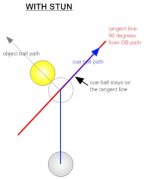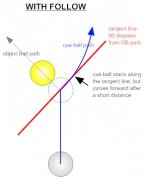i've been playing for about 6 years and i'm not sure what all this back english or br bl english stuff is.
don't think about that stuff man. just focus on making the balls and getting shape on the next ball.
all the fancy labels are what people use as excuses when they're sitting in their chairs
I can pocket balls, I can't run a rack but I can pocket them pretty decently. I want to learn how to use follow and draw as I practice my pocketing ability starting now.
Softshot
The Tangent Line is not always 90 degrees. The Tangent line is directly proportion to the angle of attack. A straight in shot has a straight Tangent line with the OB. As the angle of attack increases so does the Tanget Line. Sorry I can't explain it better with words alone.
Destrukkt
One of the big mistakes with beginners is to try and be too fancy. Move the Cue as least as you have to for position. A long make-able shot is better than a close unmakeable shot. The harder you hit the CB the less actuate your stroke is. Use English only when you need to change the Tangent Line. Drills are your best teacher after getting the correct instruction. I am guilty of not doing drills and my game suffers because of it. Pool is a life time of learning, don't rush into trying to be an expert over night. Learning the basics well, will get you there much quicker.
To the 2nd quote: To get far draw I have to hit the cueball pretty hard, to get follow I don't have to hit it so hard. This might be an error in my stroke, we'll see when someone who knows alot about pool helps me out in person.
--------------------------------------------------------------------------------------------------------------------------------------------------------------------------
Well guys I pocket balls good , the thing is I don't set-up good at all unless it's a simple setup. If I could draw , or follow and understand where the cueball will go if I make it follow and hit the bumper then I will be playing much better. My stroke could use work that's for sure as well, because I can draw one out of 5 shots, and follow every shot. Just inconsistent on these aspects.
I read all the advice and I would prefer to learn how to draw and follow to setup for my shots before, or at the same time I learn tangent lines. Tangent lines is kind of a spectator-learning skill, you watch and learn it seems which I will do.. however I want to be able to draw and follow to setup for my next shots. Drawing and following seems like all I would need to be able to setup any shot on the table, and also are the two skills I want to master. I can already follow good but just don't know where the cueball will go when I hit a cut shot with follow very much, which is probably what the tangent line is. I will learn this as I play using follow.
I will get a lesson and have him fix my stroke if there are errors in it. I might even bridge my hand wrong when I'm playing, and if Ray Martin (my instructor im going to) makes me change my bridge then all my skills are out the window and I will suck terribly. My 100% cueball follow ability will be gone, and my 20% draw will be gone (just what I can with my 2 months of playing). I don't think my bridge is off by much if it is off, I think it is wrong a little though. Anyways ill focus on this with my teacher later, for forum help the draw/follow/tangent info is what im after/
Anyways we'll see what happens when I get that lesson. Anyways until then I am trying to make sure my stroke hits the same spot, I notice when I go in to hit after 2 little aim strokes, right before the 3rd when I give the stroke strength it's aim moves. (I notice this by examining chalk marks vs the red dot I was aiming for). i will practice this. Besides that I just need to practice draw and practice learning where the cueball will go when I use my follow ability so I can use that to setup shots.
Thanks a lot everyone and anymore evidence will be great. Thanks.



